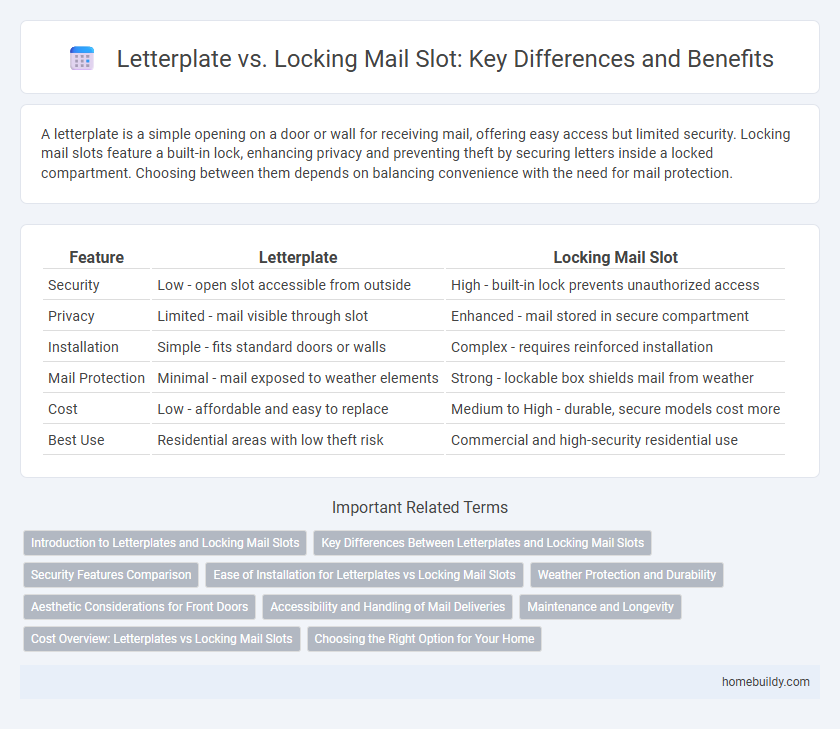A letterplate is a simple opening on a door or wall for receiving mail, offering easy access but limited security. Locking mail slots feature a built-in lock, enhancing privacy and preventing theft by securing letters inside a locked compartment. Choosing between them depends on balancing convenience with the need for mail protection.
Table of Comparison
| Feature | Letterplate | Locking Mail Slot |
|---|---|---|
| Security | Low - open slot accessible from outside | High - built-in lock prevents unauthorized access |
| Privacy | Limited - mail visible through slot | Enhanced - mail stored in secure compartment |
| Installation | Simple - fits standard doors or walls | Complex - requires reinforced installation |
| Mail Protection | Minimal - mail exposed to weather elements | Strong - lockable box shields mail from weather |
| Cost | Low - affordable and easy to replace | Medium to High - durable, secure models cost more |
| Best Use | Residential areas with low theft risk | Commercial and high-security residential use |
Introduction to Letterplates and Locking Mail Slots
Letterplates are simple, fixed openings in doors or walls designed for mail delivery, allowing easy access without additional security features. Locking mail slots incorporate a secure compartment or lock mechanism to protect mail from theft and weather damage while still supporting direct delivery through the slot. The choice between letterplates and locking mail slots depends on security requirements and convenience preferences for residential or commercial use.
Key Differences Between Letterplates and Locking Mail Slots
Letterplates are simple openings in doors allowing mail to be deposited directly inside, while locking mail slots feature a secure compartment that prevents unauthorized access. Letterplates typically do not provide security against mail theft, unlike locking mail slots that include a lockable mechanism for added protection. The materials and installation of locking mail slots are generally more robust, designed to safeguard sensitive mail and parcels effectively.
Security Features Comparison
Letterplates offer basic security by allowing mail to be delivered directly into a building, but they may be vulnerable to tampering or theft due to their simple flap design. Locking mail slots enhance security by incorporating a lock mechanism that prevents unauthorized access, ensuring mail protection from theft and tampering. High-quality locking mail slots are constructed from durable materials like stainless steel, providing resistance against forced entry and improved overall security.
Ease of Installation for Letterplates vs Locking Mail Slots
Letterplates offer significantly easier installation compared to locking mail slots, requiring only a straightforward cutout in the door or wall for fitting. They typically involve minimal tools and no complex mechanisms, making them accessible for DIY installation. Locking mail slots often demand additional hardware mounting and alignment, increasing both time and effort during the installation process.
Weather Protection and Durability
Letterplates provide superior weather protection compared to locking mail slots by featuring robust seals and durable materials that prevent rain and wind from entering the home. Their construction often includes rust-resistant metals like stainless steel or brass, ensuring long-lasting durability under harsh weather conditions. Locking mail slots, while offering security, typically lack comprehensive weatherproofing and may degrade faster when exposed to moisture and temperature fluctuations.
Aesthetic Considerations for Front Doors
Letterplates offer a sleek and minimalist aesthetic that seamlessly integrates with various front door designs, enhancing curb appeal without disrupting the door's visual flow. In contrast, locking mail slots tend to be bulkier and more utilitarian, potentially detracting from the door's overall elegance. Homeowners prioritizing refined visual harmony often prefer letterplates for their ability to maintain architectural integrity while providing functional mail access.
Accessibility and Handling of Mail Deliveries
Letterplates typically offer easier accessibility for homeowners and mail carriers due to their straightforward design and placement on doors at a convenient height. Unlike locking mail slots, letterplates do not require keys or combinations, allowing for smoother handling of everyday mail deliveries without delays or the need for physical access. In terms of security, locking mail slots provide controlled access but can sometimes hinder quick retrieval and accessibility for individuals with mobility challenges.
Maintenance and Longevity
Letterplates generally require less maintenance than locking mail slots due to their simpler design and fewer moving parts. The absence of a locking mechanism reduces the risk of malfunction and wear, contributing to the letterplate's extended longevity. Regular cleaning and occasional lubrication are typically sufficient to ensure optimal performance over many years.
Cost Overview: Letterplates vs Locking Mail Slots
Letterplates offer a more cost-effective solution compared to locking mail slots, with lower initial purchase and installation expenses. Locking mail slots involve higher upfront costs due to complex mechanisms and enhanced security features, which may also require professional fitting. Maintenance costs for locking mail slots can be higher over time, while letterplates generally incur minimal upkeep expenses.
Choosing the Right Option for Your Home
Choosing between a letterplate and a locking mail slot depends on your home's security needs and convenience preferences. A letterplate offers easy mail delivery directly into the home but lacks enhanced security features, while a locking mail slot provides secure access with a built-in lock to protect against mail theft. Assessing factors such as neighborhood safety, frequency of mail theft, and ease of mail retrieval helps homeowners select the most suitable option.
Letterplate vs Locking Mail Slot Infographic

 homebuildy.com
homebuildy.com